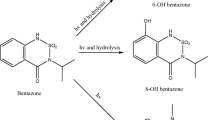Abstract
The occurrence of phenazone-type analgesics, such as aminopyrine, metamizole, phenazone and propyphenazone, has been reported in the effluent of wastewater treatment plants in µg/L concentrations. The presence of the main metabolites of aminopyrine and metamizole—acetamido antipyrine and formyl aminoantipyrine—has even been detected in sub µg/L concentrations in surface water and water bodies used to produce drinking water. This points at their high persistence and the need for adequate removal strategies. The degradation of phenazone, propyphenazone, acetamido antipyrine and formyl aminoantipyrine by UV radiation was investigated under laboratory conditions. An elucidation approach based on high-resolution mass spectrometry resulted in the identification of 11 degradation products. A mechanism of ring opening via the oxidation of the N–N bond of the pyrazolone ring was observed as well as the more typical oxidation of carbon–carbon double bonds. Aside from the degradation products, the capacity of formyl aminoantipyrine to produce trimers and dimers was demonstrated. The dimers were shown to be persistent despite continuous UV radiation. The toxicity of the degradation products was assessed by quantitative structure–activity relationships. It was shown that when the carbon–carbon double bond is partially oxidized to an epoxy the toxicity towards fish and daphnid is increased with respect to the parent compound.







Similar content being viewed by others
References
Godoy AA, Kummrow F, Paulo Augusto Z, Pamplin PAZ (2015) Chemosphere 138:281–291
Verlicchi P, Zambello E (2015) Sci Total Environ 538:750–767
Bu Q, Wang B, Huang J, Deng S, Yu G (2013) J Hazard Mater 262:189–211
Caracciolo AB, Topp E, Grenni P (2015) J Pharmaceut Biomed Anal 106:25–36
Canonica S, Meunier L, Von Gunten U (2008) Water Res 42:121–128
Miao H-F, Zhu X-W, Xu D-Y, Lu D-Y, Lu M-F, Huang Z-X, Ren H-Y, Ruan W-Q (2015) Chem Eng J 279:156–165
Loos G, Scheers T, Van Eyck K, Hoebeke L, Van Schepdael A, Adams E, Van der Bruggen B, Cabooter D, Dewil R (2018) Sep Purif Rev 195:184–191
Jia X-H, Feng L, Liu Y-Z, Zhang L-Q (2018) Chem Eng J 345:156–164
El-taliawy H, Escola Casas M, Bester K (2018) J Hazard Mater 347:288–298
Gómez MJ, Sirtori C, Mezcua M, Fernandez-Alba AR, Agüera A (2008). Water Res 42:2698–2706
Lim L, Yan F, Bach S, Pihakari K, Klein D (2016) Int J Mol Sci 17:104
Bade R, Rousis NI, Bijlsma L, Gracia-Lor E, Castiglioni S, Sancho JV, Hernandez F (2015) Anal Bioanal Chem 407:8979–8988
Svan A, Hedeland M, Arvidsson T, Jasper JT, Sedlak DL, Pettersson CE (2016) J Mass Spectrom 51(3):207–218
Yuan F, Hu C, Hu X, Qu J, Yang M (2009) Water Res 43:1766–1774
Agúndez JAG, Martinez C, Martin R, Benitez J (1994) Ther Drug Monit 16:316–322
Ahel M, Jeličic I, Daughton CG, Jones-Lepp TL (eds) (2001) Pharmaceuticals and personal care products in the environment, scientific and regulatory issues. American Chemical Society, Washington, D.C, pp 100–115
Hollender J, Zimmermann SG, Koepke S, Krauss M, McArdell CS, Ort C, Singer H, Von Gunten U, Siegrist H (2009) Environ Sci Technol 43:7862–7869
Wiegel S, Aulinger A, Brockmeyer R, Harms H, Löffler J, Reincke H, Schmidt R, Stachel B, Von Tumpling W, Wanke A (2004). Chemosphere 57:107–126
Zuehlke, S, Duennbier, U, Heberer T (2004) J Chromatogr A 1050:201–209
Gómez MJ, Martinez Bueno MJ, Lacorte S, Fernandez-Alba AR, Agüera A (2007) Chemosphere 66:993–1002
Martinez Bueno MJ, Agüera A, Gómez MJ, Hernando MD, Garcia-Reyes JF, Fernandez-Alba A (2007) Anal Chem 79:9372–9384
Feldmann DF, Zuehlke S, Heberer T (2008) Chemosphere 71:1754–1764
Gyenge-Szabó Z, Szoboszlai N, Frigyes D, Záray G, Mihucz VG (2014) J Pharmaceut Biomed Anal 90:58–63
Ternes TA, Stüber J, Herrmann N, McDowell D, Ried A, Kampmann M, Teiser B (2003) Water Res 37:1976–1982
Evgenidou EN, Konstantinou IK, Lambropoulou DA (2015) Sci Total Environ 505:905–926
Cai MQ, Wang R, Feng L, Zhang LQ (2015) Environ Sci Pollut 22:1854–1867
Favier M, Dewil R, Van Eyck K, Van Schepdael A, Cabooter D (2015) Chemosphere 136:32–41
Jedrychowski M, Huttlin E, Haas W, Sowa M, Rad R, Gygi S (2011) Molecular Cellular Proteomics 10:M111 009910
Acknowledgements
The authors would like to thank the Marie Curie initiative project Aquabase for funding under contract number MEST-CT-2004-505169. Supervision from Prof. Dr. H. Fr. Schröder and support on the Orbitrap from W. Gebhardt from the Environmental Analytical Laboratory of the Institute of Environmental Engineering of RWTH Aachen University are also greatly appreciated.
Author information
Authors and Affiliations
Corresponding author
Ethics declarations
Conflict of interest
The authors declare no financial/commercial conflict of interest.
Additional information
Published in Chromatographia’s 50th Anniversary Commemorative Issue.
Electronic supplementary material
Below is the link to the electronic supplementary material.
Rights and permissions
About this article
Cite this article
Favier, M., Van Schepdael, A. & Cabooter, D. High-Resolution MS and MSn Investigation of UV Oxidation Products of Phenazone-type Pharmaceuticals and Metabolites. Chromatographia 82, 261–269 (2019). https://doi.org/10.1007/s10337-018-3668-0
Received:
Revised:
Accepted:
Published:
Issue Date:
DOI: https://doi.org/10.1007/s10337-018-3668-0




